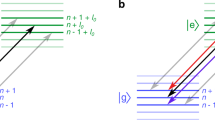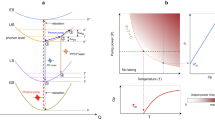Abstract
THE attempts which have so far been made to explain the observed features of the interstellar OH molecule cannot be regarded as entirely successful1. The most interesting observations are the OH sources in emission, where it is clear that some form of maser action is involved. Any theoretical model to explain these data must provide a mechanism for producing stimulated emission while also accounting for the formation and stability of the OH molecule under the conditions prevailing in the emitting region. An optical pumping device involving absorption and re-emission at λ=3080 Å in the X2II→A2Σ+ bands was suggested by Perkins et al.2, but this process has recently been criticized by Solomon3. It has been argued3 that the OH would be dissociated faster than it would be pumped by ultraviolet absorption. Solomon has in fact suggested that OH may form in the upper level of the Λ doublet by inverse pre-dissociation reactions taking place at a few thousand degrees Kelvin; but the possibility of other formation and stimulation mechanisms cannot be ruled out at the present moment.
This is a preview of subscription content, access via your institution
Access options
Subscribe to this journal
Receive 51 print issues and online access
$199.00 per year
only $3.90 per issue
Buy this article
- Purchase on Springer Link
- Instant access to full article PDF
Prices may be subject to local taxes which are calculated during checkout
Similar content being viewed by others
References
Robinson, B. J., and McGee, R. X., Ann. Rev. Astron. Astrophys., 5, 183 (1967).
Perkins, F., Gold, T., and Salpeter, E. E., Astrophys. J., 145, 361 (1966).
Solomon, P. M., Nature, 217, 334 (1968).
Ishida, K., and Akabane, K., Nature, 217, 435 (1968).
Wickramasinghe, N. C., Interstellar Grains (Chapman and Hall, 1967).
Wickramasinghe, N. C., Mon. Not. Roy. Astron. Soc., 131, 177 (1966).
Stecher, T. P., and Williams, D. A., Astrophys. J., 146, 88 (1966).
Paige, E. G. S., in Phonons in Perfect Lattices and in Lattices with Point Imperfections (edit. by Stevenson, R. W. H.), (Oliver and Boyd, 1966).
Abeles, B., Phys. Rev. Letters, 19, 1181 (1967).
Soule, D. E., Phys. Rev., 112, 698 (1958).
Klein, C. A., Rev. Mod. Phys., 34, 56 (1962).
Spitzer, L., Astrophys. J., 93, 396 (1941).
Spitzer, L., Astrophys. J., 94, 237 (1941).
Author information
Authors and Affiliations
Rights and permissions
About this article
Cite this article
WICKRAMASINGHE, N. Stimulation of Interstellar OH by Phonons. Nature 217, 1131–1132 (1968). https://doi.org/10.1038/2171131a0
Received:
Revised:
Issue Date:
DOI: https://doi.org/10.1038/2171131a0
Comments
By submitting a comment you agree to abide by our Terms and Community Guidelines. If you find something abusive or that does not comply with our terms or guidelines please flag it as inappropriate.



